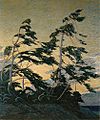Georgian Bay facts for kids
Georgian Bay (called Baie Georgienne in French) is a really big bay that's part of Lake Huron in Ontario, Canada. It's so large that some people even call it the "sixth Great Lake"! This beautiful bay is found east of the Bruce Peninsula and Manitoulin Island. To its northwest, you'll find another cool area called the North Channel.
Georgian Bay is surrounded by several different regions. These include the districts of Manitoulin, Sudbury, Parry Sound, and Muskoka. It also borders the counties of Simcoe, Grey, and Bruce.
Contents
About Georgian Bay
Georgian Bay is a huge body of water, covering about 15,000 square kilometers (5,800 square miles). That's almost as big as the entire country of Kuwait! It holds a lot of fresh water and is known for its clear, clean shores.
How Was It Formed?
The bay was shaped by ancient glaciers during the last Ice Age. As these massive ice sheets moved across the land, they carved out the deep basins and left behind the rugged landscape we see today. When the glaciers melted, they filled these basins with water, creating Lake Huron and Georgian Bay.
The Thirty Thousand Islands
One of the most famous features of Georgian Bay is its incredible number of islands. There are actually more than 30,000 islands and islets scattered across the bay! This makes it the largest freshwater archipelago (a group of islands) in the world. Many of these islands are small and rocky, while others are large enough for cottages and parks.
Wildlife and Nature
Georgian Bay is home to a wide variety of plants and animals. Its unique environment, with rocky shores, sandy beaches, and dense forests, supports many different species.
Animals of the Bay
You can find many types of fish in the bay, including walleye, pike, and bass. Birds like ospreys and bald eagles soar above the water, looking for their next meal. On land, you might spot deer, black bears, and many smaller mammals. The bay is also a stopover for many migratory birds.
Plants and Ecosystems
The forests around Georgian Bay are a mix of different trees, like pine, maple, and oak. The rocky areas have unique plants that can grow in tough conditions. This rich natural environment is why a large part of Georgian Bay is recognized as a UNESCO Biosphere Reserve. This means it's a special place where people work to protect nature while also allowing communities to thrive.
History of the Bay
People have lived around Georgian Bay for thousands of years.
Indigenous Peoples
Long before European explorers arrived, Indigenous peoples like the Anishinaabeg (Ojibwe, Odawa, and Potawatomi) and Huron-Wendat nations lived here. They used the bay for travel, fishing, and hunting. Their history and culture are deeply connected to the waters and lands of Georgian Bay.
European Exploration
The first European to explore the bay was Samuel de Champlain in 1615. He called it "La Mer Douce," meaning "The Sweet Sea," because it was so vast and fresh. Later, it was named Georgian Bay in honor of King George IV of the United Kingdom in 1822.
Fun Activities at Georgian Bay
Today, Georgian Bay is a very popular place for vacations and outdoor activities.
Boating and Water Sports
With its thousands of islands and clear waters, the bay is perfect for boating, kayaking, and canoeing. Many people enjoy swimming, fishing, and sailing here during the warmer months.
Parks and Trails
There are several provincial and national parks along the shores of Georgian Bay. These parks offer great opportunities for hiking, camping, and exploring nature. The famous Bruce Trail, one of Canada's longest footpaths, follows the edge of the Niagara Escarpment along part of the bay.
Images for kids
-
Tom Thomson, Pine Island, Georgian Bay, Winter 1914-16. National Gallery of Canada, Ottawa
-
The waters between Finger Point and Thumb Point near Cedar Springs, Beausoleil Island
See also
 In Spanish: Bahía Georgiana para niños
In Spanish: Bahía Georgiana para niños




